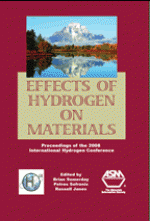Tab Article
Research and commercial activity in developing hydrogen as a fuel is driving increased attention on hydrogen-materials interactions. In particular, a renewed and intensifying interest in developing hydrogen fuel cells has prompted extensive research with the objective to enable the safe design of components for transporting and storing hydrogen fuel. This volume is the proceedings from the premier conference on hydrogen effects in materials, bridging scientific research and engineering applications. The proceedings volume highlights several themes: the technological importance of hydrogen effects on structural materials; the impact of bridging science and engineering; and the opportunity to apply new research tools, including simulation techniques as well as experimental methods.


